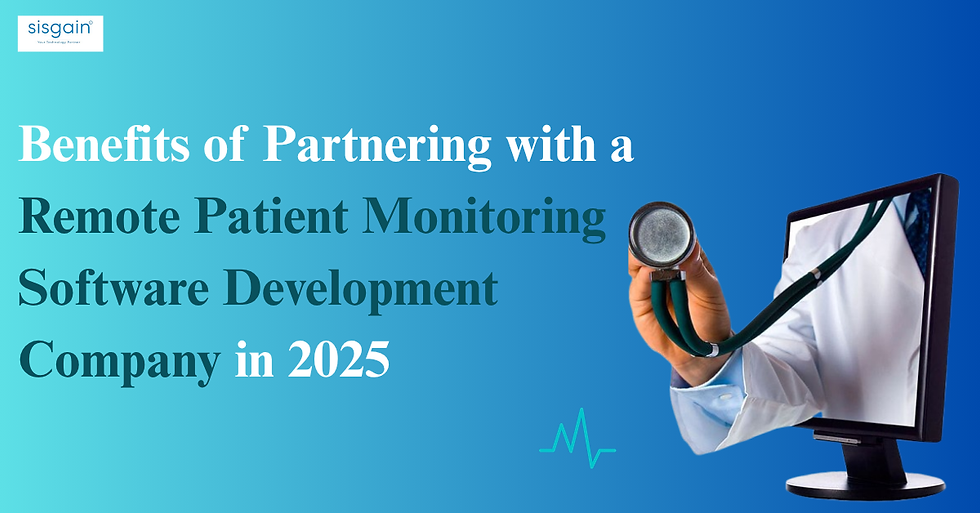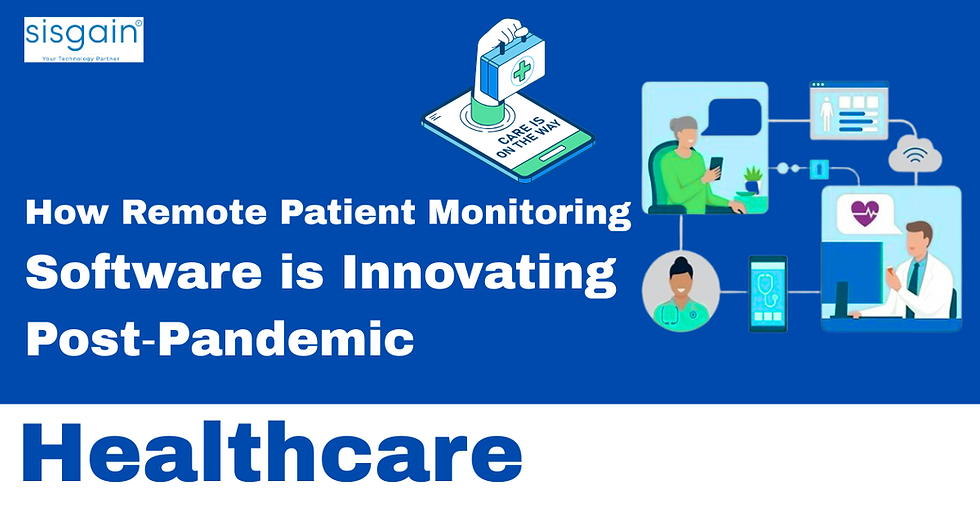Cost vs. Value: Understanding Remote Patient Monitoring Software Pricing in 2025
- sisgainweb20
- 5 days ago
- 5 min read

Healthcare is no longer confined to the four walls of hospitals. Thanks to digital innovations, patients today can be monitored and cared for from the comfort of their homes. One of the most important advancements making this possible is remote patient monitoring software. In 2025, this technology continues to reshape healthcare by allowing doctors to track patient health in real time and provide timely interventions. But for hospitals and clinics, the big question remains: How much does remote patient monitoring software cost, and is it worth the value it delivers?
This blog explores the topic of remote patient monitoring software pricing, its benefits, challenges, and why its value far outweighs the costs. Written in easy, fluent English, it is designed to guide healthcare organizations, providers, and patients in understanding the cost versus value of RPM in 2025.
What is Remote Patient Monitoring Software?
At its core, remote patient monitoring software (commonly known as RPM software) is a digital solution that collects and shares patient health data from connected devices. These devices may include wearables, mobile health apps, or medical monitors that track vital signs such as heart rate, oxygen levels, blood pressure, and glucose levels.
The RPM medical abbreviation stands for Remote Patient Monitoring. It plays a vital role in rpm health because it allows patients to be cared for outside hospitals, while doctors stay updated on their condition. Paired with monitoring telehealth, RPM creates a bridge between traditional in-person visits and modern digital healthcare services.
Why Remote Patient Monitoring is Essential in Telehealth
Telehealth has become the future of healthcare delivery, and RPM remote patient monitoring is one of its strongest components. It enables doctors to keep an eye on patients regardless of location, ensuring that people in both cities and rural areas receive timely medical attention.
Key Benefits of Combining RPM with Monitoring Telehealth:
Accessibility: Patients in underserved areas gain access to specialists.
Cost Savings: Reduced hospital visits and lower healthcare costs.
Efficiency: With remote patient monitoring platforms, doctors manage more patients at once.
Convenience: Patients avoid unnecessary travel and still receive quality care.
What Impacts the Pricing of RPM Software?
Pricing for remote patient monitoring solutions is not fixed. Several factors influence how much a healthcare provider will pay in 2025:
Number of Patients Served: The larger the patient base, the higher the overall cost, but often with volume discounts.
Integration with Systems: Advanced remote patient monitoring integration with EHRs, billing systems, and scheduling software adds to pricing.
Features Included: Tools like predictive analytics or devices such as a remote neural monitoring device increase overall costs.
Training and Support: Providers often rely on remote patient monitoring services, which include staff training and system support.
Hardware Costs: Devices like wearables, glucose monitors, or oxygen trackers may be bundled or sold separately.
Breaking Down the Cost of RPM Software
To fully understand remote patient monitoring software pricing, it’s important to look at the different components:
Software License: Typically billed monthly per patient or offered as enterprise packages.
Medical Devices: Includes wearables, blood pressure cuffs, or glucose meters.
Customization: Tailored solutions from remote patient monitoring software development teams.
System Maintenance: Continuous updates and performance optimization.
Support Services: Provided by remote patient monitoring solution providers for smooth operations.
The Value of Remote Patient Monitoring Software
The cost of remote patient monitoring software should be measured against the value it delivers. RPM impacts patients, providers, and healthcare systems in meaningful ways.
Value for Patients:
Monitoring from home provides comfort.
Real-time alerts reduce the risk of emergencies.
Patients feel empowered to manage their own health.
Value for Providers:
Access to continuous data enables quicker decisions.
Doctors manage larger patient groups with less effort.
Automation reduces manual paperwork and follow-ups.
Value for Healthcare Systems:
Reduced ER visits and readmissions cut costs significantly.
Remote patient monitoring platforms streamline patient care.
Higher patient satisfaction improves hospital ratings.
Remote Patient Monitoring Applications
The scope of remote patient monitoring applications is vast. Healthcare providers use RPM for:
Chronic Conditions: Managing diabetes, hypertension, and heart disease.
Post-Surgery Care: Tracking recovery progress to avoid complications.
Senior Care: Helping the elderly live independently while being monitored.
Neurology: Using remote neural monitoring devices to study brain activity and mental health.
Remote Patient Monitoring Companies in 2025
Today, numerous remote patient monitoring companies and remote patient monitoring software companies provide end-to-end solutions. Many also act as remote patient monitoring solution providers, offering bundled services like software, hardware, and customer support.
With a focus on rpm software development, these companies integrate AI, cloud solutions, and enhanced security to create reliable platforms that deliver both cost savings and better patient outcomes.
Emerging Trends in RPM Software Development
As technology advances, remote patient monitoring software development is evolving rapidly. Current trends include:
AI Integration: Predicting health problems before they escalate.
Remote Network Monitoring: Ensuring seamless and stable device connectivity.
Cloud-Based Solutions: Offering scalability and easy access.
Patient-Friendly Apps: Simplified interfaces that encourage daily use.
Enhanced Security: Stronger data protection for sensitive patient records.
The Importance of Integration
For RPM to succeed, smooth remote patient monitoring integration is critical. It allows RPM software to connect seamlessly with EHRs, telehealth platforms, and hospital management systems. Remote patient monitoring platforms now provide all-in-one dashboards, helping providers analyze data and respond quickly.
Pricing Models for RPM Software
In 2025, healthcare organizations can choose from several remote patient monitoring software pricing models:
Per Patient Per Month (PPPM) – Flexible and widely used.
Tiered Plans – Feature-based pricing with multiple packages.
Enterprise Customization – Personalized for large healthcare networks.
These options let providers pay according to their size and requirements.
ROI of Remote Patient Monitoring
The ROI of remote patient monitoring solutions is substantial. Providers often recover their costs within a year due to:
Fewer hospital readmissions.
Improved patient engagement.
Reduced administrative costs through automation.
Challenges in Pricing and Adoption
Despite its benefits, RPM adoption has challenges:
Variable Pricing: Vendors offer different models, making comparisons tough.
Patient Engagement: Success relies on consistent device usage.
Data Security: Protecting sensitive health information is crucial.
Working with experienced remote patient monitoring companies can help providers address these issues.
Conclusion
The conversation around remote patient monitoring software pricing in 2025 is not just about how much it costs, but also about the enormous value it brings. RPM reduces hospital visits, improves patient care, and makes healthcare systems more efficient. While costs may vary depending on features, integration, and devices, the value consistently outweighs the investment.
As rpm software development continues to grow and remote patient monitoring platforms become more advanced, the future of RPM looks bright. By choosing trusted remote patient monitoring software companies, healthcare providers can ensure they are investing wisely in both technology and healthier lives.




Comments